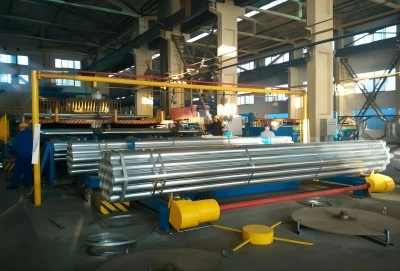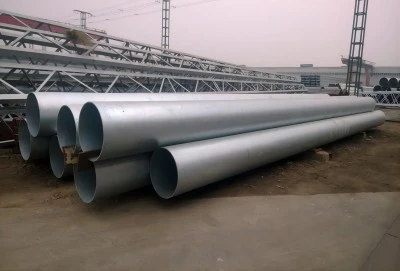Deciding whether to replace galvanized pipes is a crucial consideration for many industrial and commercial facilities. Galvanized mild steel pipe, known for its zinc coating, has been a popular choice for decades due to its corrosion resistance and durability. However, as these pipes age, they may start to deteriorate, leading to various issues. This article will guide you through the signs of pipe degradation, cost-benefit analysis, and modern alternatives to help you make an informed decision about replacing your galvanized piping system.
|
|
|
Signs your galvanized pipes need replacement
Rusty water: A telltale sign of corroding galvanized pipes
One of the most obvious indicators that your galvanized pipes may need replacement is the presence of rusty or discolored water. As the zinc coating on galvanized mild steel pipe wears away over time, the underlying steel becomes exposed to water and oxygen, leading to corrosion. This corrosion can cause rust particles to mix with the water, resulting in a reddish-brown tint. If you notice this discoloration consistently, it's a strong signal that your pipes are deteriorating and may require replacement.
Low water pressure: Clogged pipes restrict flow
Another common issue with aging galvanized pipes is a gradual decrease in water pressure. As corrosion progresses, rust and mineral deposits can accumulate inside the pipes, narrowing the passageway for water flow. This buildup can significantly reduce water pressure, particularly in areas furthest from the main water source. If you're experiencing weak water flow in multiple fixtures throughout your facility, it might be time to consider replacing your galvanized piping system.
Visible corrosion: Inspect exposed pipes for damage
In many industrial settings, sections of piping are often exposed and visible. Take the time to visually inspect these areas for signs of corrosion, such as flaking, dimpling, or discoloration on the pipe surface. Pay special attention to joints and bends, as these areas are more susceptible to wear and tear. If you notice extensive visible damage, it's a clear indication that your galvanized pipes are nearing the end of their useful life and should be evaluated for replacement.
Cost-benefit analysis of pipe replacement
Initial investment vs. long-term savings on repairsReplacing an entire galvanized piping system can be a significant upfront investment. However, it's essential to weigh this cost against the potential long-term savings on repairs and maintenance. As galvanized pipes age, they become more prone to leaks, bursts, and other issues that require frequent repairs. These ongoing maintenance costs can quickly add up, potentially surpassing the cost of a complete replacement over time. Additionally, newer piping materials often have longer lifespans and require less maintenance, further contributing to long-term cost savings.
Health risks: Lead contamination from old galvanized pipes
An often-overlooked aspect of aging galvanized pipes is the potential health risk they pose. In the past, the zinc used for galvanization sometimes contained small amounts of lead. As pipes corrode, this lead can leach into the water supply, potentially causing serious health issues for those exposed to it. This is particularly concerning in industrial settings where water might be used in manufacturing processes or for employee consumption. Replacing old galvanized pipes with modern, lead-free alternatives can significantly reduce this health risk and ensure compliance with current safety standards.
Property value: Updated plumbing increases home worth
For commercial and industrial property owners, updating the plumbing system can have a positive impact on the overall value of the facility. Modern, efficient plumbing is often seen as a valuable asset in property appraisals and can be a selling point for potential buyers or tenants. By replacing old galvanized pipes with newer materials, you're not only improving the functionality of your plumbing system but also potentially increasing the value of your property in the long run.
Modern alternatives to galvanized plumbing
Copper pipes: Durable and corrosion-resistant optionCopper piping has become a popular alternative to galvanized mild steel pipe in many industrial applications. Known for its excellent corrosion resistance and durability, copper can withstand high temperatures and pressures, making it suitable for a wide range of industrial processes. While the initial cost of copper may be higher than some other materials, its long lifespan and low maintenance requirements often make it a cost-effective choice in the long run. Copper pipes are also naturally antimicrobial, which can be beneficial in certain industrial settings where hygiene is a priority.
PEX tubing: Flexible and cost-effective replacement
Cross-linked polyethylene (PEX) tubing has gained popularity in recent years as a flexible and cost-effective alternative to traditional metal pipes. PEX is resistant to scale buildup and freezing, making it an excellent choice for various industrial applications. Its flexibility allows for easier installation, especially in tight spaces or areas with complex layouts. While PEX may not be suitable for all high-temperature or high-pressure applications, it can be an excellent choice for many water distribution systems in industrial settings.
CPVC pipes: Chemical-resistant for various applications
Chlorinated polyvinyl chloride (CPVC) pipes offer superior chemical resistance, making them ideal for industrial applications involving corrosive fluids or harsh environments. CPVC can withstand higher temperatures than standard PVC and is often used in chemical processing plants, water treatment facilities, and other specialized industrial settings. While not as flexible as PEX, CPVC is still easier to work with than metal pipes and offers excellent durability and longevity when properly installed and maintained.
Replacing galvanized pipes is a significant decision that requires careful consideration of various factors. By recognizing the signs of deterioration, understanding the cost-benefit implications, and exploring modern alternatives, you can make an informed choice about updating your industrial piping system. While the initial investment may be substantial, the long-term benefits of improved performance, reduced health risks, and potential property value increase often outweigh the costs. Consulting with a professional plumbing expert can help you determine the best course of action for your specific industrial needs and ensure a smooth transition to a more efficient and reliable piping system.
China Galvanized Mild Steel Pipe Factory
Hebei Longma Group is a leading manufacturer of galvanized mild steel pipe, offering high-quality products for various industrial applications. With advanced production equipment imported from Germany and independently developed technologies, we ensure superior product quality. Our professional team of over 300 employees, including 60+ technical experts, guarantees excellence in every pipe we produce. Our comprehensive testing facilities, including ultrasonic flaw detectors and X-ray inspection systems, ensure the highest standards of quality control. We pride ourselves on fast delivery, with standard thickness pipes ready in as little as. Our certifications, including API 5L, ISO 9001, and ISO 14001, demonstrate our commitment to quality and environmental responsibility. Thanks to our efficient production processes and strong supplier relationships, we offer competitive pricing without compromising on quality. For top-quality galvanized steel pipe, including products meeting API 5L, ASTM A53, EN10210, and AS/NZS 1163 standards, with outer diameters ranging from 60.3-1422mm and wall thicknesses of 6.02-50.8mm, contact us at info@longma-group.com.














